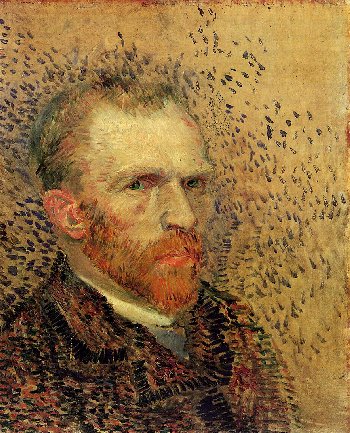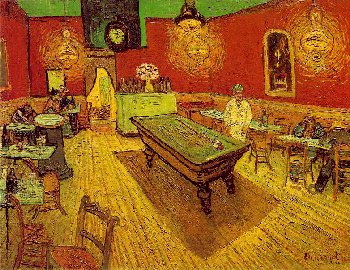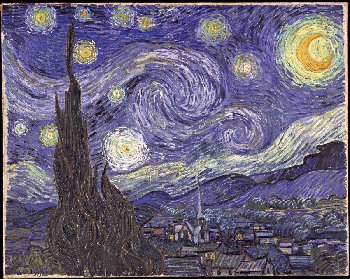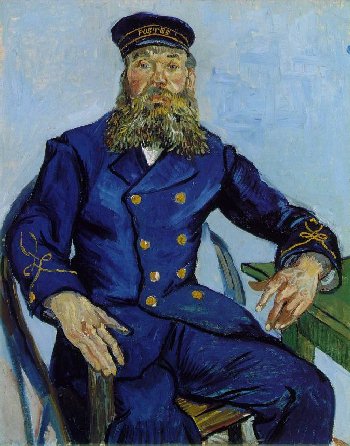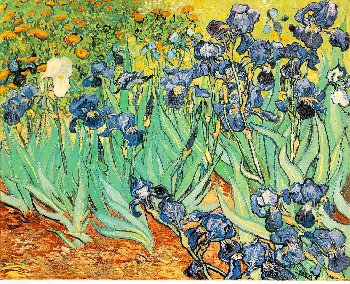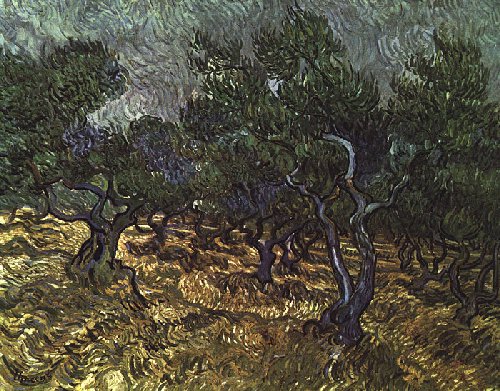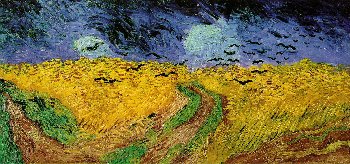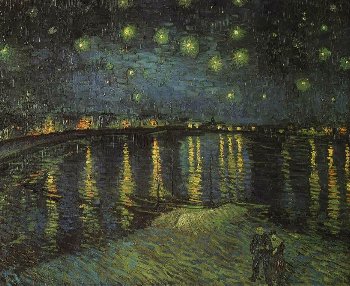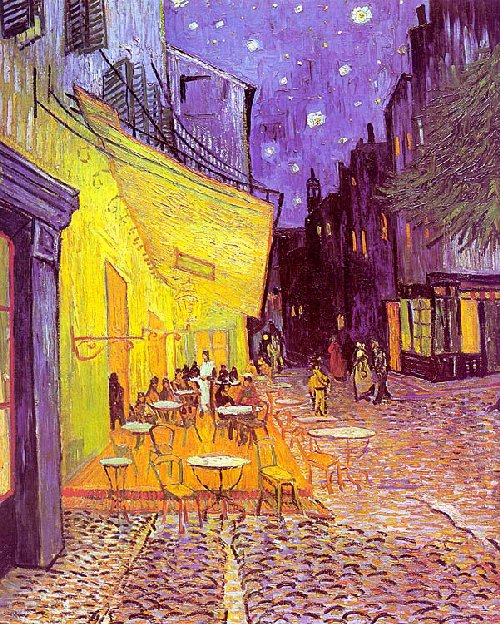| Vincent Van Gogh
The Art History Archive - Biography & Paintings
Full Name: Vincent Willem Van Gogh
Biography by Charles Moffat - May 2007. The 19th century European society of Van Gogh's time was not ready to accept his truthful and emotionally morbid way of depicting his art subjects. His internal turbulence is clearly seen in most of his paintings, which set the stage for the direction of a new style of painting called Expressionism. It is characterized by the use of symbols and a style that expresses the artist's inner feelings about his subject. The whole of Van Gogh`s painted works - over 800 canvases - were produced in the very short time span of only 8 years. Indeed his total output of over 2000 drawings and paintings originate from the period 1880-1890. Alongside these runs his great published correspondence of 800 letters, mainly to his brother Theo, and it is through this that we learn much about, although never fully understand, the tormented spirit of this eccentric genius, Vincent Van Gogh. They reveal how, having been unable to enter the ministry of the church, he gradually became taken over by his work, inextricably enslaved by its demands, in search of the ultimate `truth` and feeling "the positive consciousness of the fact that art is something greater and higher than our own adroitness or accomplishments or knowledge". This belief led him to a great modesty and he used to sign himself, if at all, only "Vincent", always knowing that his life on earth would be very short. The parish priest of Auvers-sur-Oise called him accursed and even refused to provide his hearse for Vincent`s funeral. Therefore, an understanding of the paintings by Van Gogh requires insight into his turbulent life, because his style of painting is exemplified by a projection of the painter's inner experience onto the canvas he paints. In Vincent Van Gogh's own words, he said, "What lives in art and is eternally living, is first of all the painter, and then the painting." To understand an artist of Expressionism we must first explore their biography. Many of us can identify with the roadblocks that Vincent Van Gogh experienced in his many career and romantic pursuits, all ending in failure. His reaction to these experiences however, demonstrates a biological and psychological abnormality, causing behaviors that alienated those around him. As he became more isolated from society and began to pour all of his energies into painting, his eccentricities and outbursts developed pathological traits, which caused him first, to be institutionalized, and second, it led to his suicidal death at the young age of 37. His career in the art world began in 1869 when, on the recommendation of his uncle `Cent`, a founder and shareholder, he was employed by the Goupil & Co art gallery as a clark in their Hague branch. Theo joined the Brussels office in 1873. Being transferred to London to complete his training, he fell in love with Eugénie, the daughter of his landlady, but was rejected. This led him to a period of great despair and depression, so much so that he could not attend to his duties effectively and he was transferred to Paris in 1875, where he lived in a small room in Montmatre. He was forced to resign in 1876 and immediately returned to England. Vincent`s emotional turmoil did however bear artistic fruits in the form of a remarkable gift for perception - seeing powerfully what most others did not observe at all - "sad but always cheerful" he described himself and he turned to the religious scriptures for solace, secretly harbouring the ambition to become a clergyman like his father. However, he did manage to find employment in Ramsgate, on the south coast, where he tough French, spelling and arithmetic in a small school - and was able also to linger on the beach and watch the sea. From there he found employment as assistant to the Methodist preacher Reverend Jones at Isleworth, where he came into close contact with the great squalor and poverty of his parishioners, inspiring him to a desire to live in the service of the most destitute. However, returning home to Holland for Christmas, his parents managed to talk him out of this impecunious existance and again his uncle Cent obtained for him a clerk`s job in a booksellers in Dordrecht. Unfulfilled in this work, he spent most of his time translating biblical passages into English, French and German, and his free time in the depths of the countryside where he felt at peace. His plan was to study theology and he confided in his brother: "I suppos that for a `sower of God`s words`, as I hope to be, as well as for a sower of the seed in the fields, each day will bring enough of its own evil, and the earth will produce many thorns and thistles". The image of the sower was to become a recurring theme in his work. His father finally agreed to let him follow his religious calling and sent him to Amsterdam to study for the entrance examinations to the University Theology course which, after 15 months of study, he failed, finding the work too arid, preferring to contemplate the countryside and the possibility of drawing. But the plan was not altogether abandoned and he went to Laeken, near Brussels to attend an Evangelical training school. However, he was again refused, being considered too impulsive.Not daunted by this his thoughts returned to the poverty of the London suburbs and his mission to preach in the spiritual desert, writing to Theo: "You know how one of the roots or foundations, not only of the Gospel, but of the whole Bible, is `Light that rises in the darkness`. Well, who needs this most, who will be receptive to it ? Experience has shownthat the people who walk in the darkness, in the centre of the earth, like the miners in the black coal mines, for instance, are very much impressed by the words of the Gospel, and believe them, too." He set off for Borinage, near Mons, in Belgium, to live among the miners and, being refused a teaching job at the school, settled in the village of Paturages where he taught the Bible and cared for the miners at his own expense. With his father's help he was eventually appointed lay preacher in Wasmes. His great charity at this time, his life often being compared to that of St Francis of Assisi, with such actions as giving up his bed to a poor person and sleeping on the floor, soon brought him into conflict with the established Church, which was outraged by his conduct and he was forced to resign. He continued his work for a while at Cuesmes but increasingly turned to drawing. In the summer of 1880, at the age of 27, he decided to devote himself entirely to drawing and became a full-time artist. Supported financially by Theo he went to study at the Académy des Beaux-Arts in Brussels. During his short and turbulent life, he sold only 1 painting for 400 francs, just 4 months before his death. It is titled "The Red Vineyard" (See painting below). Nonetheless, he produced an incredible number of masterpieces that will continue "living" for the rest of human history. Most casual art lovers see Van Gogh as a troubled, but successful artist. This is far from the actual truth of his turbulent life, which was fraught with failure in every occupational pursuit he attempted including painting, and was marked by intermittent episodes of depression, violence and acting out behaviors. Thanks to the preservation of 1000's of letters Van Gogh had written to friends and family, especially to his brother Theo, we have a nearly complete understanding of his feelings, experiences, and views on every aspect of his life. Surprisingly, his incredible artistic talent went undeveloped and unrecognized until he was 27 years old, after he had already failed at two other career choices, as an art dealer and a Protestant minister. Under the shroud of family shame when he was found incompetent to follow in his father's ministerial foot steps, he began to study art. He obsessively poured himself into this newly found talent and completed thousands of sketches and oil paintings before he shot himself to death at the age of 37 years old. Many observers of Van Gogh's life justifiably believe that his eccentricities, which were visible from early childhood, compounded to create many distressing experiences that directly impacted the development of Expressionism. Painting was no longer the medium used primarily to capture photographic images. It became a crucible that could hold all of the artist's passions, conflicts, and unrealized dreams. Thus, a look into his childhood will give us an understanding of Van Gogh's creative expression, as well as an understanding of the origins of Expressionism.
|
||
| ||
 Vincent's sister, Elizabeth Van Gogh, described his demeanor as a child. He was "intensely serious and uncommunicative, and walked around clumsily and in a daze, with his head hung low." She continued by saying, "Not only were his little sisters and brothers (he was the oldest of 8) like strangers to him, but he was a stranger to himself."
Vincent's sister, Elizabeth Van Gogh, described his demeanor as a child. He was "intensely serious and uncommunicative, and walked around clumsily and in a daze, with his head hung low." She continued by saying, "Not only were his little sisters and brothers (he was the oldest of 8) like strangers to him, but he was a stranger to himself."
A servant who worked for the Van Gogh family when Vincent was a child described him as an, "odd, aloof child who had queer manners and seemed more like an old man," than the child he was. Vincent was a disappointment to his mother, and eventually to his entire family, even his beloved brother Theo Van Gogh who supported him financially for the 10 years that he worked as a painter. In Vincent's own words, he says of Theo, that he was the one "who comforts his mother and is worthy to be comforted by his mother." On the other hand, Vincent was rejecting and obstinate, making himself inaccessible to all family members, except for Theo. Vincent later described his childhood as "gloomy and cold and sterile." Unaware of his own artistic genius, Vincent Van Gogh first tried to learn the art of selling the works of other artists. As a young man of 16, he became apprenticed to an art dealer at the firm of Goupil & Co. located at The Hague, in Belgium, and later transferred to the London and Paris galleries. He quickly learned all the painters and their respective styles and what constitutes a valuable piece of artwork. In fact, he actually learned too well! If a customer became interested in purchasing a poorly done painting, Van Gogh would provide a long discourse on why it was a piece of junk. He was even known to become argumentative with many of the art patrons. Following his failure as an art dealer, Vincent Van Gogh later wrote to his sister Wilhelmina Van Gogh that the galleries and art firms "are in the clutches of fellows who intercept all the money," and that only "one-tenth of all the business that is transacted…is really done out of belief in art." Vincent Van Gogh did not understand the mechanics of interpersonal diplomacy, or the principles of salesmanship. During this period he fell in love for the first time, and openly professed his love for Eugenia, a respectable upper class woman. Eugenia was insulted by his unwanted advances, and she harshly rebuffed him. Van Gogh's inability to read the intent and emotions of others, caused him to fail to see that she had never expressed any interest in him. Failing in his first romantic experience, he also blundered miserably in his first job as an art dealer. He was dismissed by the art firm, and with a relatives help, he temporarily took a position as an assistant teacher and curate. Following a short stint as a teacher, he returned home to Holland for a visit with his parents and decided to stay. He took a job in a bookshop. While working as a clerk for the bookseller, he rented a room with a family named Rijken. Mrs. Rijken said that she had to scold numerous youngsters for taunting Vincent Van Gogh and calling him "a queer freak." He was only 24 years old. Vincent soon realized that he was also inadequate as a teacher and a bookseller, and he was becoming desparate to find work. His parents were reluctant to continue supporting their oldest son, who was a failure in their eyes. This drew him to finally attempt to satisfy his father's greatest wish that he become a minister. In Amsterdam, he began studying for the University entrance exams in theology, but soon found that he did not have the ability to learn the required math and foreign languages. With a relative's help he entered an evangelical school in Brussels and subsequently became a missionary preacher in the Borinage, a mining district in Belgium. Van Gogh found his personal calling working among the downtrodden miners and their families, and was known to give away his clothing and money to help the poor living in shacks on the blackened earth of the coal fields. Nonetheless, he could not convincingly communicate his religious feelings to his flock, and while viewing the pride that they could maintain in spite of their miserable living conditions, they influenced Vincent to take on their lower class beliefs. His own religious convictions began slipping away, no longer seeming adequate or relevant. Living in the same filth and poverty that his brethren were forced to experience, he lost religion but gained a new fascination in his charcoal drawings of the peasant class living around him. Vincent returned home for an extended visit and fell deeply in love with his first cousin Kee Vos, who had also been staying with his family. However, for someone to merely contemplate marriage with one's own cousin was a serious breach of an important taboo strongly held in 19th century Holland. Interestingly, Kee, like Eugenia his first love, had no interest in Vincent (See Kee's photo below). Undaunted by her obvious disinterest in him, Vincent attempted to visit her at her family's home, but was refused entry. Kee's father repeatedly told him that she was not at home. Vincent thought that her family was keeping her away from him against her will, and that she was actually at home. Forcing a dramatic encounter with Kee's father, Vincent impulsively attempted to demonstrate the intensity of his affections for Kee. He held his hand in the flame of a kerosene lamp and said to Kee's father, "Let me see her for as long as I can keep my hand in the flame!" After blowing the flame out, Kee's father took Vincent to a nearby saloon to get him intoxicated and to reduce his extreme agitation. Then he convinced Vincent that Kee could not see him, and that their relationship had no future. When Van Gogh's father, a devoted Christian minister (See photo below), discovered that Vincent had fallen in love with Kee, his first cousin, and that he had also strayed from his religious beliefs, a bitter quarrel caused a life-long break in the father/son relationship. Cast from the family home, Vincent Van Gogh threw himself into his artwork and began a relationship with a low class prostitute named "Sien." She moved in with him and he became deeply empathetic with her own personal suffering. Van Gogh not only lovingly sketched her image (See the drawing titled "Sorrow" below), but because she was in poor health, he also took care of all her needs. However, because she was a prostitute, the Van Gogh family was scandalized by her presence in Vincent's living quarters, which further caused friction in Vincent's relationship with them. Van Gogh's eccentric behavior increased as his contempt for middle-class proprieties soon alienated all who tried to help him. He began wearing ragged, unwashed clothing, did not respond to acquaintances on the street, and lived an isolated existence. His only activity was to draw and paint in ways that conveyed his sympathies for the hard lives of peasants. His greatest painting, "The Potato Eaters" was the result of his deep empathy with the peasant class (See painting below). An old man reported that when he was ten years old he knew Vincent Van Gogh, who he frequently saw painting landscapes in Nuenen, Belgium. From the viewpoint of children in the neighborhood, Vincent Van Gogh was a curious sight indeed. He would sit on a stool alongside a roadway painting scenery for hours at a time. The witness describes Van Gogh as a "funny, red-bearded man with a straw hat, smoking a pipe and painting intently, and not responding to anyone's attempts to communicate with him." In his many letters, it is clear that Van Gogh was aware of his depressive tendencies, and that he had experienced them most of his life. After one of his mental crises he wrote "Well, even in that deep misery I felt my energy revive, and I said to myself: in spite of everything I shall rise again, I will take up my pencil, which I have forsaken in great discouragement, and I will go on with my drawing, and from that moment everything has seemed transformed in me." Van Gogh seemed to utilize the incredible high spirits, which always followed his severe depressions, as a source of his creative energy. In 1886, at the age of 33, Van Gogh went to Paris and mingled with Toulouse-Lautrec, Gauguin, Seurat, and other painters who were later considered among the best. His painting techniques were influenced by these impressionists, and their use of bright colors and their choice of less sentimental subject matter altered the direction his style of painting would take. Unless depression overcame him, he carefully avoided his tendency to paint dark canvases and subjects who were weighted down with the drudgeries of life. However, after two years of working among the Parisian artistic community, Van Gogh's delicate nervous system began to collapse. His friendship with Paul Gauguin was in Van Gogh's own words, "electric," but like all of his other relationships it was doomed by Van Gogh's inability to comprehend normal social relationships. On December 24, 1888, an argument ensued between them. Van Gogh unsuccessfully attacked Gauguin, then mutilated himself by cutting a large piece off of his ear (See his famous painting below in which he depicts the injury), he wrapped the severed ear in paper, and gave it to a startled prostitute whom he had befriended. When his brother learned of this incident, he had Vincent institutionalized for two weeks in Arles, France in 1888. This was followed by several more breakdowns in 1890. Psychologists studying Van Gogh's history of mental breakdowns have theorized that each mental crisis was preceded by a perceived threat to the deep attachment he felt for a loved one. His first collapse occurred shortly after his beloved brother Theo Van Gogh, had announced his engagement to his future wife Johanna. Vincent's second mental breakdown came a few days after a violent argument and the hasty departure of his close friend, fellow painter Paul Gauguin. His third mental crisis occurred shortly before the wedding of his brother Theo. Apparently, Vincent perceived the romantic relationship between Theo and Johanna, and their subsequent marriage, as a loosening of the bonds he held with his brother. In May 1890, he stayed for three days with Theo, his wife and new baby. Theo's lung condition had grown worse, and Vincent was clearly concerned with his brother's health. Selfishly, he was also worried about Theo's deteriorating financial prospects, which had already reduced the living allowance that was sent to Vincent each month. Reflecting his plunging mood Vincent painted "The Undergrowth With Two Figures" in June 1890, 1 month before his suicide death. It has a lonely and depressive style and coloration (See painting above). In one of his last letters dated July 1890, he sadly wrote to his brother Theo, "I feel...a failure. That's it as far as I'm concerned...I feel that this is the destiny that I accept, that will never change." In contrast, one of his last paintings which he completed in late July 1890 titled "Wheat Field With Crows," reflects an ambivalence of optimism and hopelessness with the dark clouds of depression slowly lifting up from the skyline (See painting below). It is common knowledge among clinical psychologists that a person with bi-polar disorder (known as manic depression during Van Gogh's time), invariably attempt suicide while rising up from the depression towards the manic phase. A few days after he finished this painting, Vincent Van Gogh, on July 29, 1890, killed himself with a gunshot to the chest. His brother Theo died of lung disease 6 months after the death of Vincent. Although he only sold one painting during his life-time, he is considered the most powerful Expressionist, and his paintings each sell for millions of dollars. Ironically, Vincent Van Gogh is deemed by society to be one of our greatest and most successful artists. The intense interest that today's society has for Van Gogh lies not in the quality of his paintings, but in his ability to project his turbulent emotional experience onto the canvas. Because he was an Expressionist, we know more about his mental state than we do ANY other great painter in history. For example, his painting "Starry Night Over The Rhone" (see below), gives us the sense that he was just beginning to plunge into a state of depression. This painting was created in Arles, France in September, 1888, and it remains housed in the Musée d'Orsay in Paris. Van Gogh's state of mind at the time he painted it can only be speculated about. It is suspected that he was probably on the verge of going into a deep depressive state. The very dark colors, with glimpses of light are typical of his style during the early phase of his depressive episodes. So to, is the appearance of the shadowy figures of a man and woman in the far right-hand corner of the painting, widely believed to be suggestive of his dependent, yet ambivalent relationship with his brother and sister-in-law. In general, Van Gogh's mood had began to sour while he was in France, surrounded by many great painters of the day. His awkwardness in social relationships began to take a toll. He was plagued by frequent extreme shifts in his emotional state. Mania and feelings of grandiosity were always followed by self-loathing, and the despair of deep depressions. It appears likely that just after he completed the painting above, he sunk further into the depths of depression. We know that two months later, on December 24, 1888, his mood began to revert back to the manic state, when his violent argument with Gauguin occurred. It resulted in self-mutilation, which is a common behavior in mental patients during manic excitement. Without access to modern medicine, the frequency of these self-destructive episodes increased until Van Gogh's suicide in 1890. From a behavioral standpoint, Van Gogh's ability to express his internal state of mind in his artwork, provides us with a vivid record of the see-saw activity of his brain's chemistry. When he began to slip into depression, his paintings would take on a deep, dark feeling of doom, with only hints of light optimism remaining. However, as the depression deepened, his canvases become dark vessels of hopelessness. Amazingly, a complete reversal would always occur, catapulting him into a frenzy of grandiose feelings and creative activity as the mania took hold. His paintings would become electric with brilliant colors, and the canvas textures jumped to life with jittery strokes of paint, brilliantly mirroring his manic state of mind. Because Van Gogh was an Expressionistic painter, we know more about his internal life than we do about any of civilization's other Master painters. He alone has allowed us to peer into his mind, while he was in the act of creating his art. This is truly the unique and lasting contribution that Vincent Van Gogh has given to us in the study of our great Masterpieces. Additional Quote: "I have a terrible need of -- dare I say the word? -- religion. Then I go out at night to paint the stars..." - Vincent van Gogh, Arles, 1888.
Paintings by Van Gogh
| ||
